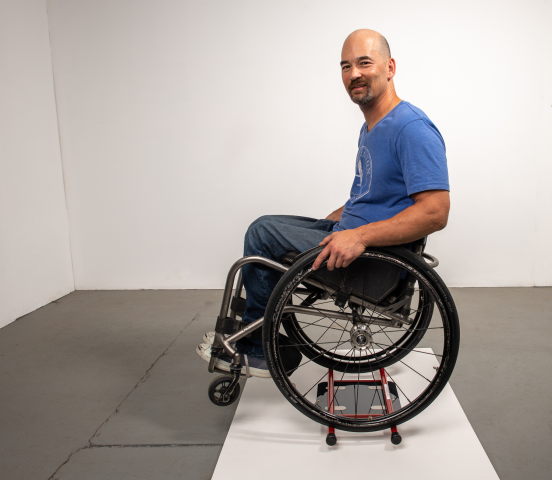ARTHUR TORREY

Electronics, Mechanical Design and Fabrication
I have been a Wheelchair User since a spinal cord injury in 2010. I have experience with a variety of mobility devices. I’m and active participant in the WheelchairDriver.com online community. (A highly recommended resource for power chair users!) While as a paraplegic, I can and sometimes do use a manual chair, I generally use a power chair as I feel that I can do more when I use one as it keeps at least one hand free to carry or move things as I need to.
I am an active member and volunteer at the Artisan’s Asylum in Somerville, MA. The Artisan’s Asylum is one of the worlds top maker-spaces with a huge number of shared shops and an amazing community of makers doing everything from fine arts to heavy duty engineering. I take great advantage of the many shared shops, including woodworking, welding, precision machining, electronics, fabric arts and more. While sometimes a challenge to use much of our equipment from a wheelchair, it allows me to design an make a lot of different kinds of things.
Mobility Innovations:
Design and fabrication of devices used by Erik Kondo for wheelchairboarding.
Design, development and fabrication of Adaptive Rock Climbing equipment.
Using gear personally designed and built, has become one of two paraplegics known to LEAD climb, both indoors in a rock climbing gym and outside on real rocks. Tinkerer and repair person, working on, and fixing anything from motorcycles to appliances.
In a team with Erik Kondo, we were one of the ten first stage winners of the Toyota Mobility Design Competion with our development of a wheelchair accessible hoverboard. I was responsible for the mechanical design and construction of several prototypes, including all of the CNC machining. We created versions in different widths to fit different chair sizes, along with a special model which Erik used in an effort to be the first wheelchair user to ride a hoverboard to the top of Mount Washington in an annual event held for unusual ‘first ascents’ up the Auto Road. While unsuccessful in making it all the way, he did get about 2/3 of the way up before the board overheated and shut down.
We then applied the same concept for holding a chair to solving a problem that is a challenge for most wheelchair users, namely watching our weight. Because we can’t stand on a typical bathroom scale, or the one at the doctor’s office, it can be a much greater challenge to find out what we weigh. The existing solutions tend to be large and expensive or difficult to use / access. At the same time, because we spend our time ‘sitting around’ obesity is an even larger problem for wheelchair users than it is for AB’s. In an effort to solve this, we created the “Wheelie Scale” an open-source-hardware design for a simple adapter that fits over a low-cost commercial bathroom scale, and which will allow any manual chair user to get a number to track their weight changes.

The Wheelie Scale is used by putting the adapter (red) on the scale and backing onto it so the rear wheels fit into the space between the bars. The scale (ideally one with a Bluetooth output to a phone or other device) can then display the weight on the adapter. Ideally if the user can pop and hold a wheelie, it gives the weight of the user and chair. If not it at least gives the weight that is on the rear wheels. Many people want to then do math to subtract the weight of the chair, etc. but really it isn’t needed. The chair isn’t going to change, so just look at if the weight goes up or down, isn’t that the important part?
Here is Erik doing a demo in Wheelie style:

I won a grant from the Nielsen Foundation for entrepreneurs using wheelchairs and hope to find a way to bring the adapter to market as while the design is simple, relatively few wheelers have the skills or equipment needed to make it.